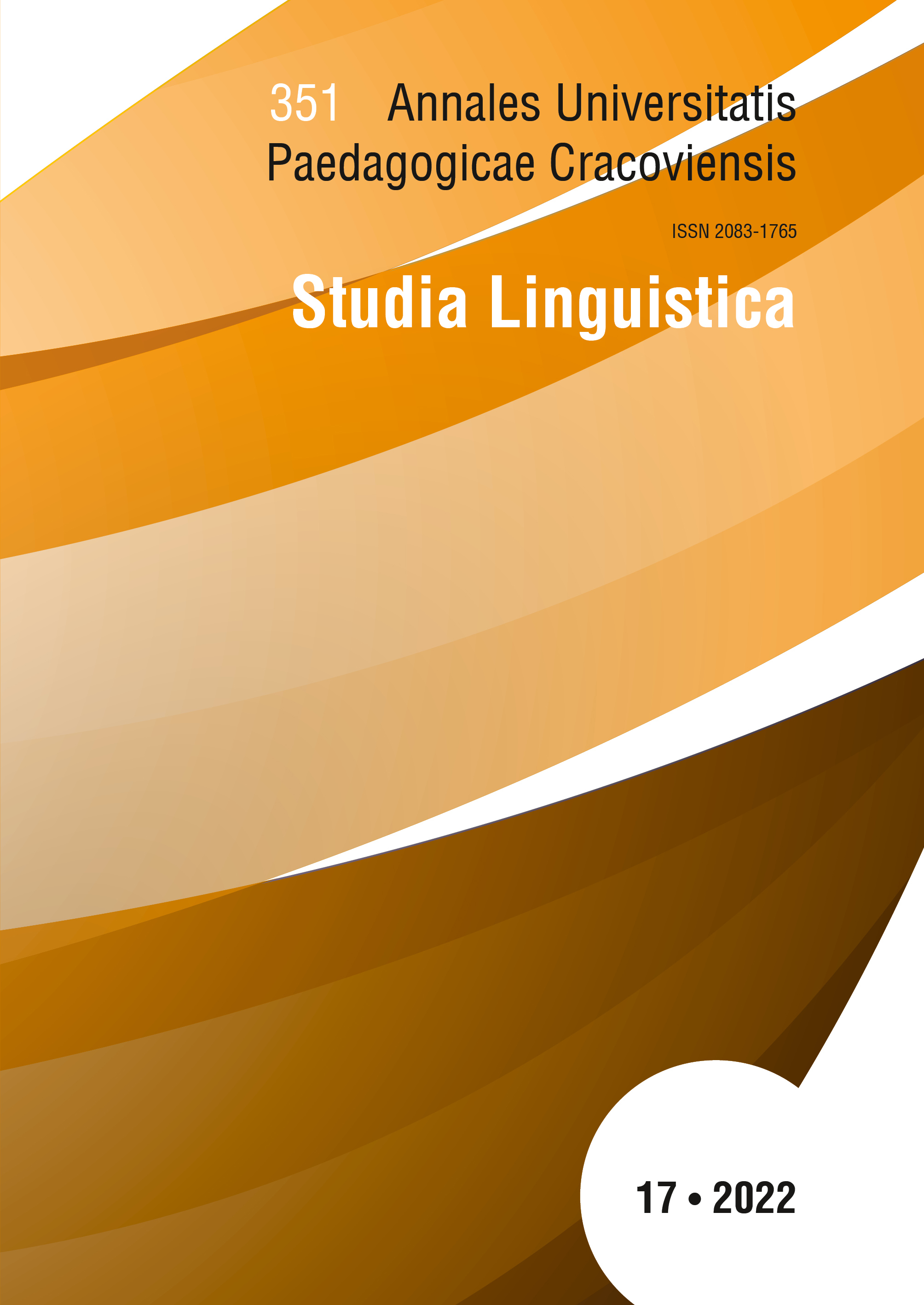On functions, structure and nomenclature of trachea in medical sciences, in the history of the Polish language and dialects
Main Article Content
Abstract
This paper is devoted to the lexeme tchawica from a diachronic perspective. The first part is the description of a trachea (its functions and structure) as an anatomical organ, which is followed by the analysis of its etymology. The main focus of investigation is the description of tchawica in the history of the Polish language and dialects. For this purpose, synonyms, derivatives, variant forms (in terms of phonetics and morphology), names based on foreign words (derived from Latin and Greek), as well as hybrid names, have been pointed out. According to the analysis, these names are differentiated both in terms of motivation and form.
Downloads
Article Details

This work is licensed under a Creative Commons Attribution-NonCommercial-NoDerivatives 4.0 International License.
Author, submitting a text to the editorial board of the journal “Annales Universitatis Paedagogicae Cracoviensis. Studia Linguistica", certifies that the content of the article has not been published so far and that the work does not violate in any way the copyright or related rights of other person, as well as other rights of third parties, and that no one's rights to the work (or any part thereof) have been missed. After signing the contract, the property rights to the published materials are transferred to the Scientific Publisher of the University of the National Education Commission, Krakow.
“Annales Universitatis Paedagogicae Cracoviensis. Studia Linguistica” is an open access journal, and all its content is made available free of charge to users and institutions under the Creative Commons CC-BY-NC-ND 4.0 license (attribution, non-commercial use, no derivative works). Under this license, the authors agree that their work may be lawfully reused for any purpose, except for commercial purposes, without the prior consent of the author or publisher. Everyone can read, download, copy, print, distribute and process these works, provided that the author's marking and the original publication place are correct. Published texts may not be used to create derivative works (e.g. to translate and publish in another language without the consent of the publisher). This is in line with the BOAI (Budapest Open Access Initiative) definition. "Studia Linguistica" does not charge for submitting or processing articles.
References
Bednarczuk L., 1986, Pochodzenie i kariera przyrostka -ol, ,,Rocznik Naukowo-Dydaktyczny WSP w Krakowie. Prace Językoznawcze” V, s. 143–150.
Google Scholar
Gryglewski R.W., 2021, Historia medycyny w sześciu niepełnych odsłonach. Część pierwsza, czyli pierwsze trzy odsłony, Kraków.
Google Scholar
Górski P., Grzelewska-Rzymowska I., 2020, Pneumonologia w gabinecie lekarza Podstawowej Opieki Zdrowotnej, Warszawa.
Google Scholar
Grzegorczykowa R., 1999, Dzieje i współczesne rozumienie wyrazów duch i dusza, [w:] W zwierciadle języka i kultury, red. J. Adamowski, S. Niebrzegowska, Lublin, s. 333–340.
Google Scholar
Grzegorczykowa R., Puzynina J., 1979, Słowotwórstwo współczesnego języka polskiego. Rzeczowniki sufiksalne rodzime, Warszawa.
Google Scholar
Hamerlińska-Latecka A., 2015, Onkologopedia. Logopedia wobec chorób nowotworowych, Bydgoszcz.
Google Scholar
Horyń E., Michalik M., 2020, Jabłko Adama vel grdyka – konteksty leksykograficzne, kulturowe, medyczne, „Annales Universistatis Paedagogicae Cracoviensis 306, Studia Linguistica” XV, s. 79–89.
Google Scholar
Hrabec S., Pepłowski F., 1963, Wiadomości o autorach i dziełach cytowanych w słowniku Lindego, Warszawa.
Google Scholar
Kleszczowa K. (red.), 1996, Słowotwórstwo języka doby staropolskiej. Przegląd formacji rzeczownikowych, Katowice.
Google Scholar
Kuczkowski J., 2014, Anatomia i fizjologia obwodowego i ośrodkowego narządu mowy. Patofizjologia narządu mowy, [w:] Biomedyczne podstawy logopedii, red. S. Milewski, J. Kuczkowski, K. Kaczorowska-Bray, Gdańsk, s. 104–140.
Google Scholar
Kuczkowski J., 2016, Anatomiczno-fizjologiczne podstawy głosu, [w:] Logopedia artystyczna, red. B. Kamińska, S. Milewski, Gdańsk, s. 258–275.
Google Scholar
Latkowski J.B. (red.), 2004, Otorynolaryngologia dla studentów medycyny i stomatologii, Warszawa.
Google Scholar
Lewaszkiewicz T., 1977, Wypowiedzi S.B. Lindego o leksykalnym i znaczeniowym wzbogacaniu polszczyzny, „Poradnik Językowy”, z. 8, s. 345–350.
Google Scholar
Michajlik A., Ramotowski W., 1998, Anatomia i fizjologia człowieka, Warszawa.
Google Scholar
Pluta-Wojciechowska D., 2013, Zaburzenia czynności prymarnych i artykulacji. Podstawy postępowania logopedycznego, Bytom.
Google Scholar
Sokołowska-Pituchowa J. (red.), 2019, Anatomia człowieka. Podręcznik dla studentów medycyny, Warszawa.
Google Scholar
Sokólska U., 2015, Nazwy głowy i jej części w gwarach podlaskich, [w:] Dialog pokoleń w języku potocznym, w języku wsi i miasta, w literaturze, w publicystyce, w tekstach kultury, red. E. Wierzbicka-Piotrowska, Warszawa, s. 195–208.
Google Scholar
Szczeklik A., 2007, Kore. O chorych, chorobach i poszukiwaniu duszy medycyny, Kraków.
Google Scholar
Thorwald J., 2018, Kruchy dom duszy. Porywająca historia zuchwałych pionierów neurochirurgii, Warszawa.
Google Scholar
Wysocka F., 1994, Polska terminologia lekarska do roku 1938, t. II. Anatomia. Jednowyrazowe nazwy motywowane, Kraków.
Google Scholar
Wysocka F., 2007, Polska terminologia lekarska do roku 1838, t. III. Anatomia. Nazwy dwuwyrazowe, Kraków.
Google Scholar
Zieliński K.W., 2019, Słownik pochodzenia nazw i określeń medycznych. Antyczne i nowożytne dzieje chorób w ich nazwach ukryte, Łódź.
Google Scholar

